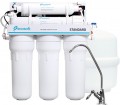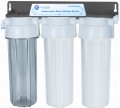Stages of purification
The number of purification stages provided for in the filter design. At each stage, water passes through its own filter element, clearing itself of certain contaminants; in this case, the steps are arranged in order from coarser cleaning to finer. For example,
a three-stage system may look like this: the first stage is mechanical removal of impurities, the second stage is the removal of ferrous, and the third is filtration through a carbon cartridge.
The more stages of purification — the more advanced the filter is considered, the cleaner water it usually provides at the outlet. Accordingly, this moment largely depends on the purpose (see “Type”): for example, multi-stage filtration is quite rare in main models, it is practically not used at all in pre-filters, but the number of stages can reach 9 in models for sink.
Pollution clipping
The smallest size of foreign particles (in microns) that the filter can hold in total. Accordingly, the smaller this size, the higher the filtration efficiency, the less undissolved impurities remain in the filtered water. On the other hand, finer cleaning usually takes more time, which affects the speed (throughput) of the filter. It should be noted that in the case of using reverse osmosis filters, the filtration is very fine, up to 0.01 microns.
Types of filtration
Substances from which the filter is able to purify water. Some models may also indicate a specific degree of purification in percent for each point; the higher this indicator, the more efficiently the filter is able to cope with its functions. This list will be especially useful if you know what exactly is the most polluted water in your area — it will allow you to choose the model that is most suitable for specific conditions. In addition, in the case of softening systems (see "Type"), this data helps to determine the specific type of device — softener or iron remover.
The most common contaminants today are:
—
Mechanical impurities. Particles of small size, insoluble in water and in a state of suspension. An example of such impurities is fine sand.
—
Organic impurities. Impurities of various substances of organic origin — benzene, chloroethanes, chlorethylenes, etc. Many of these substances are harmful to humans. Unlike the mechanical impurities described above, "organics" refers to chemical contaminants — such substances dissolve in water, and they have to be filtered at the molecular level. This requires the use of fairly advanced filters. It is also worth mentioning that some types of organic substances — in particular, phenol, pesticides and petroleum products — stand out in separate categories, the possibility of filtering them is specifically stipulated in the specs
...of the filters. This is due to their prevalence and popularity: the term "organic impurities" is not clear to everyone, but the danger of pesticides or petroleum products is well known. See below for details on individual types of organic contaminant.
— Active chlorine. Chlorination is still used in some plumbing systems as a disinfectant. As a result, water supplied to consumers often contains dissolved chlorine, which is harmful to health. Some filters with this function, in addition to chlorine, are also able to remove hydrogen sulfide and other gases dissolved in it, which affect water quality and give it an unpleasant odour. However, these possibilities should be specified separately.
— Iron. Iron is known to many as an important trace element necessary for the functioning of the body; however, a person needs very little of it, and iron impurities in drinking water only harm the body. Note that such impurities can be present in different forms; therefore, different types of filters are required to filter them. So, one of the most famous options is colloidal iron: very small undissolved particles that give the water a characteristic “rusty” colour, as well as a metallic taste and smell. This type of impurities is effectively filtered by osmotic membranes (see "Reverse osmosis"). Also, such membranes cope well with bacterial iron — it is also in the form of insoluble microscopic particles, accumulates a specific type of bacteria that lives in water pipes. But for soluble forms (ferrous hydroxide, chloride and ferrous sulfate), it is necessary to use specialized cleaning and softening systems — iron removers; see "Type" for details. Summing up, we can say that when choosing a device with this type of filtration, it is necessary to take into account the specific form of iron that you have to deal with. At the same time, water can contain several types of such impurities at the same time, which may require complex filtration.
— Ions of heavy metals. In this case, we can also talk about salts of heavy metals: ions are formed when any salts are dissolved in water. Most heavy metals — accordingly, their compounds — are toxic to humans.
— Pesticides. Various chemicals used to combat harmful microorganisms, fungi, weeds, various agricultural pests (insects, rodents), etc. Most pesticides are toxic chemicals and are toxic to humans.
— Nitrates. Salts of nitric acid, which are a common component of mineral fertilizers (saltpeter) in particular. Most of the nitrates are converted into safe compounds during use, but excess fertilizers can end up in drinking water.
— Cadmium. A metal used in particular in anti-corrosion coatings, batteries and inorganic dyes. Poisonous both by itself and in various compounds.
— Petroleum products. Oil and various substances obtained from it (gasoline, kerosene, diesel fuel, fuel oil, etc.). It is poisonous when taken orally.
— Hardness salts. Compounds that give water increased hardness are primarily calcium and magnesium salts. Water purification from such salts is carried out by purification and softening systems based on the principle of ion exchange. For more information about such devices, see "Type", here we note that if the specs of the cleaning and softening system indicate the filtration of hardness salts, then we have a classic softener, if not — an iron remover.
This list is not complete, modern filters can specialize in other types of pollution. For example, for many main models (see "Type"), filtration from sand and clay is separately claimed. In our catalog, such moments are described in the paragraph “Additional cleaning".Min. operating pressure
The lowest inlet water pressure at which the filter is able to fully perform its functions. Indicated for models with a connection to the water supply — directly or through a tap (see "Connection").
The design of some filters requires a certain level of inlet pressure for normal operation; if the pressure is insufficient, both throughput and overall filter efficiency suffer, and some functions are not available at all. The latter is especially true for reverse osmosis (see above). Therefore, if the minimum operating pressure is directly indicated in the filter characteristics, you should make sure that your water supply system complies with this parameter before purchasing.
Note that for filters with a booster pump, this column indicates the lowest pressure at which the filter still does not require the use of a pump; see "Pump" for details.
Max operating temperature
The highest inlet water temperature at which the filter is able to operate normally. Modern filters are conditionally divided into models for cold and hot water: the operating temperature in the first case does not exceed 40 °C, and in the second it can reach 95 °C. For more information on the importance of matching water temperature and filter characteristics, see "Purpose".
Replacement cartridges
Models of replaceable cartridges for which the filter is designed. Knowing the names of models, it will be much easier for you to find a replacement for an exhausted cartridge. In addition, the options directly named by the manufacturer are fully compatible with the filter and correspond to official specifications, while there is no such guarantee for "non-native" cartridges.
Several names in this paragraph are usually indicated for filters with multi-stage filtration (see "Stages of purification") — a cartridge for each stage.
Pump
The filter has its own
pump. This feature is found mainly in two types of filters. The first is reverse osmosis systems (see above): the operation of such filtration requires high pressure, but it is not always achieved at the inlet, and a pump, usually electric, is provided to increase the pressure. The second option is tourist filters (see "Type"), where the pump is designed to draw water from natural reservoirs; they have to be pumped manually.
Tap
The presence of its own
tap in the design of the filter. It provides the convenience of draining water from the device. Only two types of filters are equipped with a tap (see "Type"): tabletop ones, in which it is attached directly to the body, and those that are mounted under the sink (here a separate tap is installed next to the main kitchen one). In both cases, this element is almost mandatory, but the other types of filter types do not need a tap and are not equipped with it.

